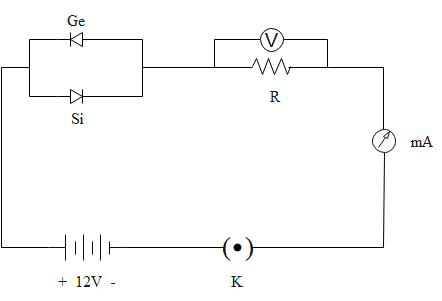
Germanium and silicon junction diodes are connected in parallel. These are connected in series with a resistance $\mathrm{R}$, a milliammeter $(\mathrm{mA})$ and a key $(\mathrm{K})$ as shown in Fig. When key $(\mathbf{K})$ is closed a current begins to flow in the milliammeter. The potential drop across the germanium diode is then

(A) 0.3 V
(B) 0.7 V
(C) 1.1 V
(D) 12 V
Answer
216k+ views
Hint: We know that diode (PN junction) in an electrical circuit allows current to flow more easily in one direction than another. Forward biasing means putting a voltage across a diode that allows current to flow easily, while reverse biasing means putting a voltage across a diode in the opposite direction. The Forward bias decreases the resistance of the diode whereas the reversed bias increases the resistance of the diode. In forward biasing the current is easily flowing through the circuit whereas reverse bias does not allow the current to flow through it.
Complete step by step answer
We know that forward bias or biasing is where the external voltage is delivered across the P-N junction diode. In a forward bias setup, the P-side of the diode is attached to the positive terminal and N-side is fixed to the negative side of the battery.
Reverse biased diode means that the positive end of the battery is connected to the negative end of the diode and the negative end of the battery is connected to the positive end of the diode. A diode is an electrical component acting as a one-way valve for current. When voltage is applied across a diode in such a way that the diode allows current, the diode is said to be forward-biased.
The germanium diode is reverse biased and the silicon diode is forward biased. Therefore, there will be no current in the branch of germanium diode. The potential barrier of silicon diode is $0.7 \mathrm{V}$. Therefore, for conduction minimum potential difference across silicon is $0.7 \mathrm{V}$.
Maximum potential difference across resistance, $\mathrm{R}=12-0.7=$$11.3 \mathrm{V}$
So, the correct answer is option B.
Note: The forward bias causes a force on the electrons pushing them from the N side toward the P side. With forward bias, the depletion region is narrow enough that electrons can cross the junction and inject into the p-type material. The width of the depletion layer in a p-n junction diode decreases in forward bias due to repulsion of carriers from battery terminals, holes from p-type and electrons from n-type. Now, due to the small number of ions in the depletion region its potential decreases. Due to this increased depletion width and barrier potential, no charge carriers have the energy to cross the junction so no current flows across the diode. If two diodes are connected in parallel, both forward biased, then current flows through the diode having lesser barrier potential.
Complete step by step answer
We know that forward bias or biasing is where the external voltage is delivered across the P-N junction diode. In a forward bias setup, the P-side of the diode is attached to the positive terminal and N-side is fixed to the negative side of the battery.
Reverse biased diode means that the positive end of the battery is connected to the negative end of the diode and the negative end of the battery is connected to the positive end of the diode. A diode is an electrical component acting as a one-way valve for current. When voltage is applied across a diode in such a way that the diode allows current, the diode is said to be forward-biased.
The germanium diode is reverse biased and the silicon diode is forward biased. Therefore, there will be no current in the branch of germanium diode. The potential barrier of silicon diode is $0.7 \mathrm{V}$. Therefore, for conduction minimum potential difference across silicon is $0.7 \mathrm{V}$.
Maximum potential difference across resistance, $\mathrm{R}=12-0.7=$$11.3 \mathrm{V}$
So, the correct answer is option B.
Note: The forward bias causes a force on the electrons pushing them from the N side toward the P side. With forward bias, the depletion region is narrow enough that electrons can cross the junction and inject into the p-type material. The width of the depletion layer in a p-n junction diode decreases in forward bias due to repulsion of carriers from battery terminals, holes from p-type and electrons from n-type. Now, due to the small number of ions in the depletion region its potential decreases. Due to this increased depletion width and barrier potential, no charge carriers have the energy to cross the junction so no current flows across the diode. If two diodes are connected in parallel, both forward biased, then current flows through the diode having lesser barrier potential.
Recently Updated Pages
Circuit Switching vs Packet Switching: Key Differences Explained

Mass vs Weight: Key Differences Explained for Students

Alpha, Beta, and Gamma Decay Explained

Alpha Particle Scattering and Rutherford Model Explained

Angular Momentum of a Rotating Body: Definition & Formula

Apparent Frequency Explained: Formula, Uses & Examples

Trending doubts
JEE Main 2026: Application Form Open, Exam Dates, Syllabus, Eligibility & Question Papers

JEE Main Correction Window 2026 Session 1 Dates Announced - Edit Form Details, Dates and Link

Derivation of Equation of Trajectory Explained for Students

Hybridisation in Chemistry – Concept, Types & Applications

Understanding the Angle of Deviation in a Prism

Understanding Collisions: Types and Examples for Students

Other Pages
JEE Advanced Marks vs Ranks 2025: Understanding Category-wise Qualifying Marks and Previous Year Cut-offs

How to Convert a Galvanometer into an Ammeter or Voltmeter

Atomic Structure: Definition, Models, and Examples

Ideal and Non-Ideal Solutions Explained for Class 12 Chemistry

Degree of Dissociation: Meaning, Formula, Calculation & Uses

Understanding Electromagnetic Waves and Their Importance




